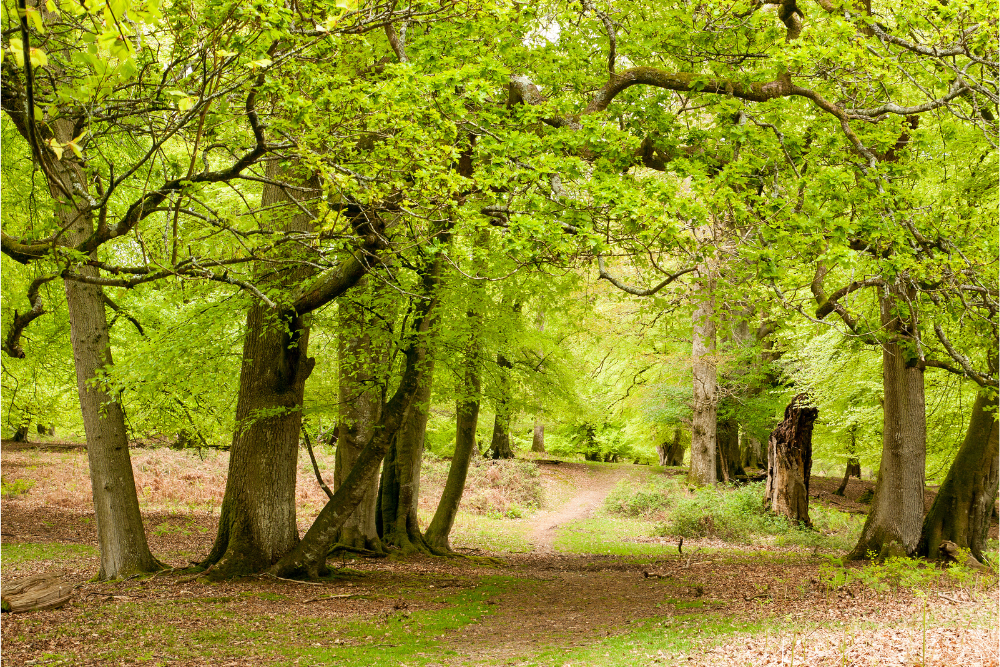
Covering some 220 square miles of the county of Hampshire – and a bit of Wiltshire – the New Forest is one the largest remaining areas of unenclosed heathland, forest, and pasture in southern England.
It is one of the latest additions to the register of Britain’s National Parks, but the New Forest is anything but new! It was established way back in 1079 by William the Conqueror as a royal park for hunting deer and wild pigs.
Situated squarely on England’s sunny south coast, the New Forest is readily accessible from many parts of the UK – barely a stone’s throw from London, the Midlands, or the south west. So, let’s take a closer look at some of the reasons for visiting the New Forest.
Natural beauty
The New Forest is renowned for its stunning landscapes, which include ancient woodlands, heathlands, and picturesque villages. It’s a haven for nature lovers, with lush greenery, serene lakes, and open moorlands.
Walking or cycling through the forest trails allows you to immerse yourself in all the tranquillity and beauty of the surrounding forest. The change of seasons brings a variety of colours and scenery, from vibrant spring blossoms to the golden hues of autumn – it’s the ideal year-round destination.
They are so numerous that it’s difficult to highlight the top beauty spots. The 200 acres of Exbury Gardens, for example, have been described as “heaven with the gates open”. The gardens are world-renowned thanks to the unique collection of rhododendrons and azaleas planted by the Rothchild family. In peak bloom the plants tower over visitors in a profusion of flowers from white, to cream, to palest green.
Exbury Gardens also plays host to the Five Arrows Gallery where local artists and photographers display their interpretations of local wildlife and landscapes.
Wildlife
The area is home to a variety of animals, including the famous New Forest ponies, which roam freely across the heathland. Deer, foxes, and many bird species can also be observed in their natural habitat. Birdwatchers and wildlife enthusiasts will find the New Forest a paradise for spotting rare and interesting species.
Although they roam free throughout the forest, Bolderwood is probably the best place to be certain of viewing at least some of the New Forest’s five species of deer – from the majestic Red deer, to Fallow deer, Roe deer, Sika, and Muntjac.
The enclosure at Bolderwood offers a protected area of the forest and a sanctuary for many types of deer. From a purpose-built platform, you can overlook the meadows in which the deer are grazing and even coordinate your visit with feeding times.
Towns, history, and cultural heritage
The New Forest is dotted with historical sites, including ancient churches, traditional thatched cottages, and remnants of past settlements. The many strands of its cultural history are brought together in some of the best-known towns.
Lyndhurst, for example, became the forest’s “capital” from the earliest years of William the Conqueror’s visits. The small town is today home to the New Forest Heritage Centre – a museum and exhibition hall where you can trace the millennia of forest history. Lyndhurst is also the location of the Verderers Court – first set up in the 13th century as a court responsible for ruling the forest, with authorisation from the Crown and elections from the County.
Lewis Carroll is probably the best-remembered children’s author, but did you know that the grave of Carroll’s original Alice in Wonderland – Alice Liddell (later Hargreaves) – can be found in Lyndhurst’s churchyard?
Visiting the New Forest means you get to enjoy stunning natural landscapes, serene lakes, picturesque villages, and observe free-roaming wildlife like the iconic New Forest ponies and various deer species. The area also offers rich cultural history, with historical sites, museums, and charming towns like Lyndhurst. It’s a tranquil escape with diverse outdoor activities year-round.

